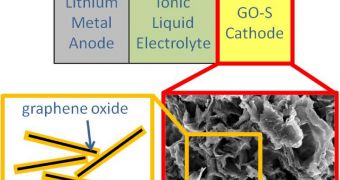In a recent study, investigators with the US Department of Energy's (DOE) Lawrence Berkeley National Laboratory (Berkeley Lab) were able to create a new type of lithium-sulfur (Li/s) battery, which is capable of holding twice the amount of electricity its lithium-ion counterparts can.
According to the research team, the Li/s battery can withstand in excess of 1,500 charge-discharge cycles without experiencing any significant loss of performance in terms of capacity. This makes this device the most efficient and long-lived lithium-sulfur battery ever developed.
The power source was created as a response to the increasing energy demands posed by modern-day electronic devices, including laptops, smartphones, tablets and portable mp3 players. Additionally, the new battery could be used to power electric and hybrid electric vehicles more efficiently in the future.
One of the greatest challenges associated with these vehicles is boosting their range, power and speed to the levels enabled by combustion engines. Even the latest generations of lithium-ion batteries are not efficient enough to match these criteria, but the Li/s battery might just be.
Current lithium-ion batteries have a cell-level specific energy of around 200 Watt-hours per kilogram (Wh/kg), but a 300-mile (482-kilometer) driving range would require between 350 and 400 Wh/kg.
The leader of the new research, Berkeley Lab Environmental Energy Technologies Division (EETD) scientist Elton Cairns, says that the new Li/s battery produces an initial energy of 500 Wh/kg, which then decreases to more than 300 Wh/kg over sustained use.
This level is maintained even after more than 1,000 charge-discharge cycles. What this implies is that further improvements in the new technology could lead to electric vehicles capable of covering huge distances without needing a recharge.
“Our cells may provide a substantial opportunity for the development of zero-emission vehicles with a driving range similar to that of gasoline vehicles,” Cairns explains. A paper detailing the new Li/s battery appears in the latest issue of the scientific journal Nano Letters.
The investigation was sponsored by grants from the DOE Office of Science and the University of California, through a Proof of Concept Award.

 14 DAY TRIAL //
14 DAY TRIAL //